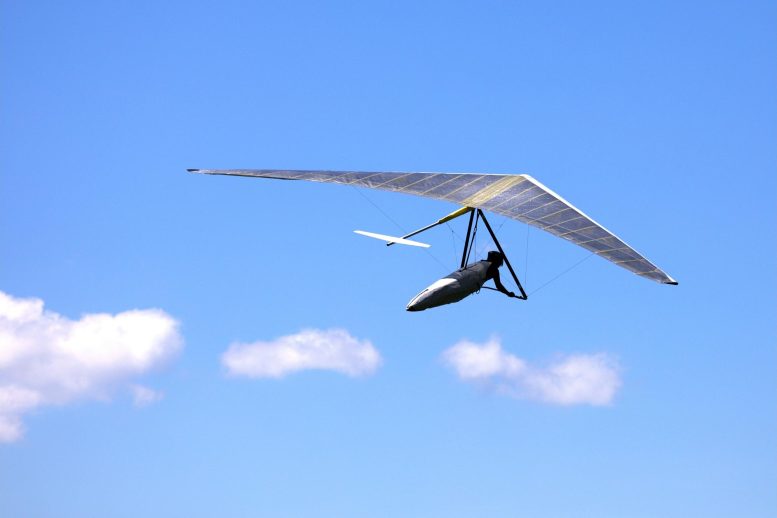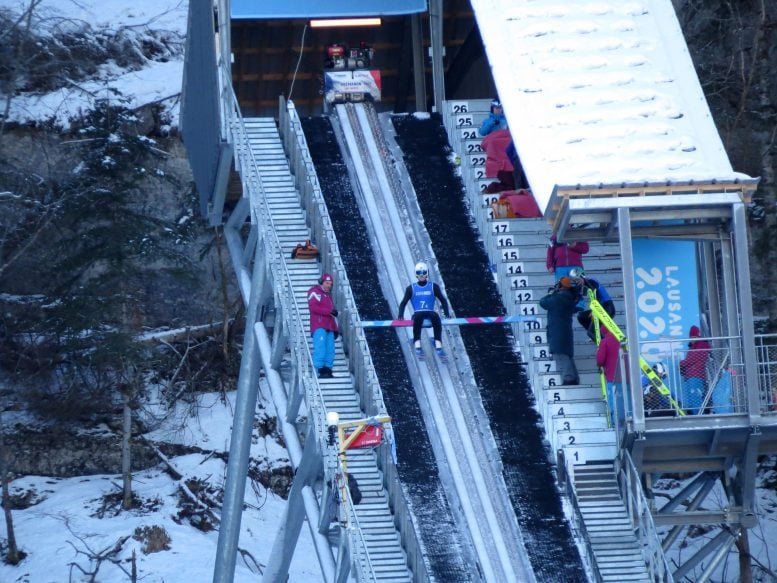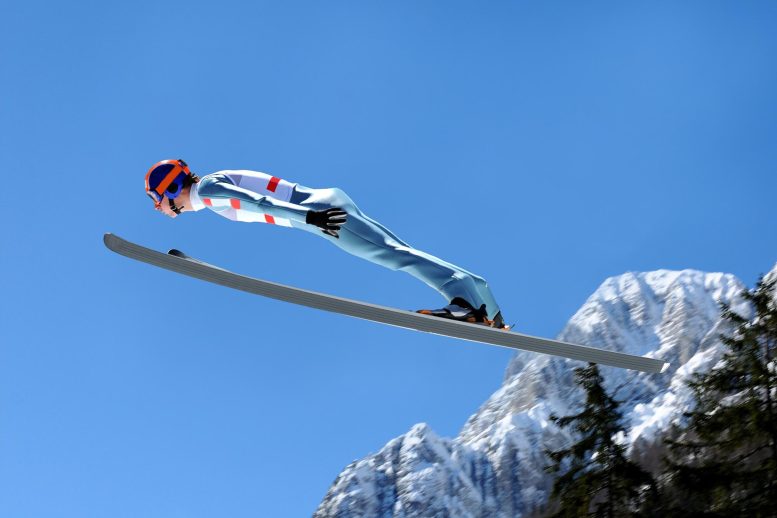If you or I jump in the air as high as possible, we can stay off the ground for about half a second. Michael Jordan could stay aloft for almost one second. While there are many events at the Winter Olympics that feature athletes performing feats of athleticism and strength while high in the air, none blur the line between jumping and flying quite as much as the ski jump.
I teach students about the physics of sports. The ski jump is perhaps one of the most intriguing events in the Winter Games to showcase physics in action. The winner is the athlete who travels the farthest and who flies and lands with the best style. By turning their skis and bodies into what is essentially a wing, ski jumpers are able to fight gravity and stay airborne for five to seven seconds as they travel about the length of a football field through the air. So how do they do this?

Hang gliders have large wings, are very aerodynamic and are very light, all of which maximize lift to produce long flights despite the lack of an engine.
How to fly
Three major concepts from physics are at play in the ski jump: gravity, lift, and drag.
Gravity pulls any object in flight down toward the ground. Gravity acts on all objects equally and there is nothing athletes can do to lessen its effect. But the athletes also interact with the air as they move. It is this interaction that can produce lift, which is an upwards force produced by air pushing on an object. If the force produced from lift roughly balances the force of gravity, an object can glide or fly.
To produce lift, an object needs to be moving. As the object moves through the air, its surface collides with air particles and pushes these particles out of the path of the object. As air particles are pushed down, the object is pushed up according to Newton’s Third Law of motion which says that for every action, there is an equal and opposite reaction. Air particles pushing an object upwards are what create lift. Increasing speed as well as increasing surface area will increase the amount of lift. The angle of attack – the angle of the object relative to the direction of air flow – can also affect lift. Too steep and the object will stall, too flat and it won’t push down on air particles.
While this all may seem complicated, sticking your hand out of a car window illustrates these principles perfectly. If you hold your hand perfectly flat, it will stay more or less in place. However, if you tilt your hand so that the bottom is facing the direction of the wind, your hand will be pushed upwards as the air particles collide into it. That is lift.
The same collisions between an object and air that provide lift also produce drag. Drag resists the forward motion of any object and slows it down. As speed decreases, lift does too, limiting the length of a flight.
For ski jumpers, the goal is to use careful body positioning to maximize lift while reducing drag as much as possible.
During excellent jumps, athletes will maximize lift and glide long distances.
Flying on skis
Skiers start high up on a slope then ski downhill to generate speed. They minimize drag by crouching down and carefully steer to reduce friction between the skis and ramp. By the time they reach the end, they can be going 60 miles per hour (96kph).
The ramp ends at a takeoff point which, if you look closely, is actually at a slight downward angle of 10 degrees. Just before the athletes reach the end of the ramp, they jump. The ski landing slope is designed to mimic the path a jumper will take so that they are never more than 10 to 15 feet (3 to 4.6 meters) above the ground.
Once the athletes are in the air, the fun physics begins.
The jumpers do everything they can to produce as much lift as possible while minimizing drag. Athletes will never be able to generate enough lift to overcome gravity entirely, but the more lift they generate, the slower they will fall and the further down the hill they will travel.
To do this, athletes align their skis and body nearly parallel to the ground and place their skis in a V-shape just outside the form of the body. This position increases the surface area that generates lift and puts them in the ideal angle of attack that will also maximize lift.
As drag reduces the speed of the skier, lift decreases and gravity continues to pull on the jumper. Athletes will begin to fall faster and faster until they land.

Many regulations – like the height of the starting point and ski length – are variable depending on conditions and the athlete’s height and weight. Credit: DarDarCH
The rules follow the physics
With so much physics at play, there are a lot of ways wind, equipment choices, and even the athletes’ own bodies can affect how far a jump can go. So to keep things fair and safe, there are a lot of regulations.
While watching the events, you may notice officials moving the starting point up or down the slope. This adjustment is made based on the wind speed as faster headwinds will produce more lift and result in longer jumps that could go past the safe landing zone.
Ski length is also regulated and tied to a skier’s height and weight. Skis can at most be 145% of the skier’s height and skiers with a body mass index less than 21 must have shorter skis. Long skis are not always the best as the heavier the ski, the more lift you need to produce to stay airborne. Finally, skiers must wear tight-fitting suits to ensure that athletes will not use their clothing as an additional source of lift.
As you tune into the Olympics to marvel at the physical power of the athletes, take a moment to consider also their mastery of the concepts of physics.
Written by Amy Pope, Senior Lecturer of Physics and Astronomy, Clemson University.
This article was first published in The Conversation.![]()









Start working from home! Great work for-Ever, Stay at Home Moms OR anyone needs an extra income. Get started. You only need a computer and a reliable computer connection so don’t
get late try……http://www.worksilver.cf
[] Confirm you are not a spammer.
Did you lie and check the box? Then how can we trust other things you say?